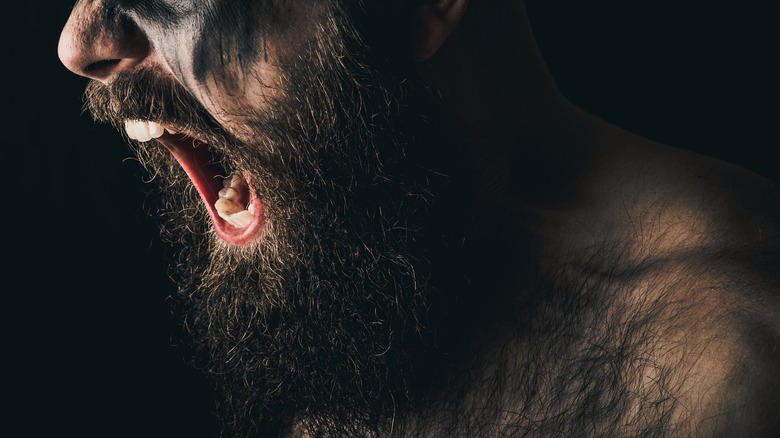How Do Metal Vocalists Scream?
If you asked folks to try their best "metal scream," you'd likely get a whole bunch of differently goofy attempts. After all, folks like vocalist Jared Dines on YouTube asked the public for exactly this. Looking to the professionals: There's the raspy, but still tonal, vocal fry of James Hetfield from Metallica or Joe Duplantier of Gojira; the ultra-high, glass-shattering scream of Judas Priest's Rob Halford; the completely unintelligible low-lows of Cannibal Corse's George Fisher — and everything in between. Thrash, doom, power, or any other glint of metal: They've all got their versions of throaty rage.
Your own best attempt at these screams — shielded by the privacy of a shower or daily car commute, perhaps — would likely leave you coughing and gasping for air. Reason being, there's a very specific, very trainable set of vocal techniques that singers have to practice day in and day out in order to not permanently ruin their vocal chords. Anyone can scream for help or shout at a dog who peed on the carpet, but very few can do it night after night without going to the hospital. Matt Heafy from Trivium screamed incorrectly for years, for instance, and after a vocal blowout in 2014 thought he'd never sing again, as Metalhead Zone explains. In the end, screaming revolves around regulated breathing, muscular control, and using one's "false vocal folds," as sites like The Naked Vocalist explain.
Air flow vs. vocal chord tension
Former Archenemy lead vocalist Angela Gossow (above) ran a workshop about metal screaming where she went into the basics. And if anyone knows how to scream, it's Gossow, as the workshop on YouTube illustrates. For those who need to express themselves in this way and purge their inner fire, she says, learning is possible.
Vocal chords, located in the throat, open and close when someone talks. When someone sings, the vocal chords vibrate really quickly. As Power to Sing (also posted on YouTube) shows, vocal chords almost look like waves flowing open and closed. When someone shouts, the vocal chords lock up. Right above the vocal chords are the "false vocal folds," or ventricular folds, as The Naked Vocalist calls them. These are basically thick patches of muscle that tighten up when screaming.
Screaming requires the right balance between "air pressure and vocal chord tension" to control the flow of air out of the lungs, throat, vocal chords, and ventricular folds. It's kind of a cousin skill to the "circular breathing" needed to play the bagpipes or didgeridoo. Per Sing and Scream, this method of control leads to every distorted, staticky, or creaky vocal sound a person can make, like those employed by metal vocalists.
Incorrect screaming can lead to "vocal nodules" that break a voice. Even Gossow had to take six months to relearn everything she knew about singing when she was diagnosed with nodules prior to an Archenemy tour in Japan, as Medchrome relates.
Perfected by babies and wielded by Vikings
On Metal Sucks, Dr. Krzysztof Izdebski of the Pacific Voice and Speech Foundation says that metal singers essentially re-learn the kind of "scream and growl, and inhalation and high pitch and whistle and low pitch" that comes naturally to babies. Using a 16,000-frame-per-second camera he discovered that screamer's vocal chords never touch at all, saying, "the vocal folds do open and vibrate but actually don't collide, and ... everything claps and dances, basically, and creates vibrations and creates acoustic orchestration ... The air that comes through produces turbulence, and the turbulence produces the sound."
Babies cry to get people's attention. In the same way, it makes sense that our ancestors shouted to scare away predators. After all, if you feel pain, like from a wolf's teeth or cat's claw, what do you do? Scream your brains out.
As PBS Learning points out, screaming was a part of not only metal and rock going back to Black Sabbath and Led Zeppelin, but back to Screamin' Jay Hawkin's "I Put on a Spell on You" (1956), a song once deemed too "weird and visceral" for the public, per The Current. And of course, Vikings were using growling, howling vocal stylings going back to the 10th century. "Never before have I heard uglier songs than those of the Vikings. The growling sound coming from their throats reminds me of dogs howling, only more untamed," one historian wrote. To that, metalheads proudly reply, "Yep, sounds about right."


